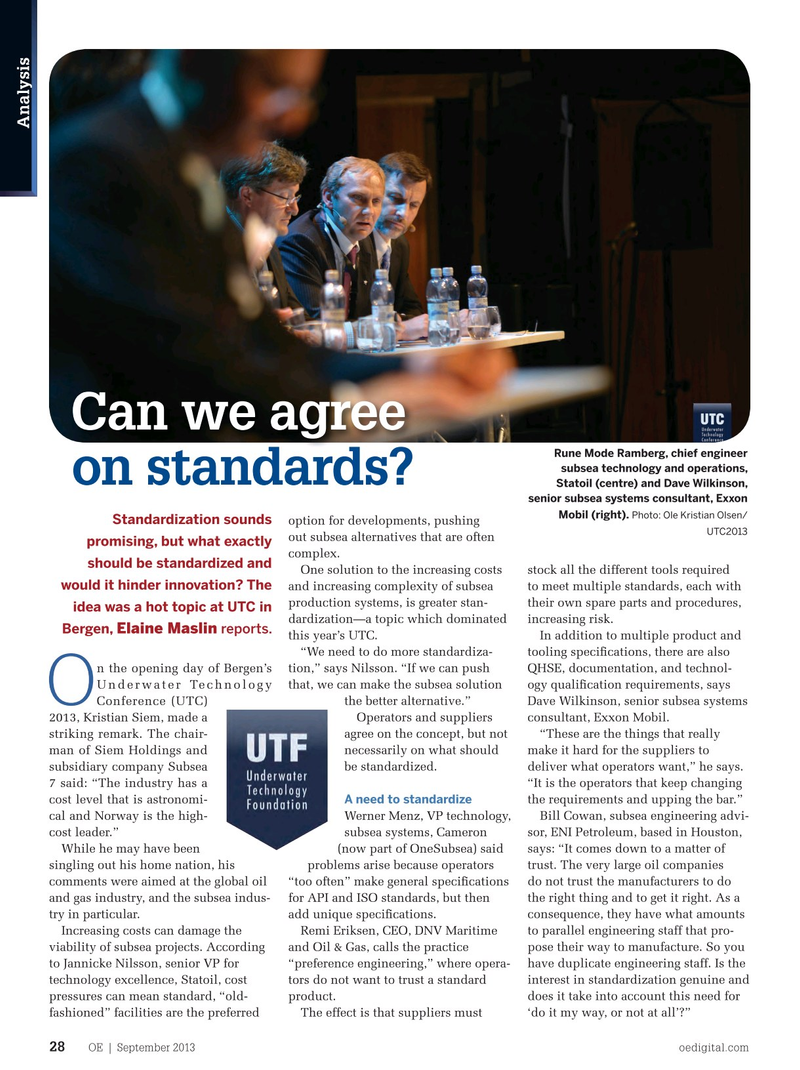
Page 26: of Offshore Engineer Magazine (Sep/Oct 2013)
Read this page in Pdf, Flash or Html5 edition of Sep/Oct 2013 Offshore Engineer Magazine
Analysis
Can we agree Rune Mode Ramberg, chief engineer subsea technology and operations, on standards?
Statoil (centre) and Dave Wilkinson, senior subsea systems consultant, Exxon
Mobil (right). Photo: Ole Kristian Olsen/
Standardization sounds option for developments, pushing
UTC2013 out subsea alternatives that are often promising, but what exactly complex.
should be standardized and
One solution to the increasing costs stock all the different tools required would it hinder innovation? The and increasing complexity of subsea to meet multiple standards, each with production systems, is greater stan- their own spare parts and procedures, idea was a hot topic at UTC in dardization—a topic which dominated increasing risk.
Bergen, reports.Elaine Maslin this year’s UTC. In addition to multiple product and “We need to do more standardiza- tooling specifcations, there are also n the opening day of Bergen’s tion,” says Nilsson. “If we can push QHSE, documentation, and technol-
Underwater Technology that, we can make the subsea solution ogy qualifcation requirements, says
Conference (UTC) the better alternative.” Dave Wilkinson, senior subsea systems
O 2013, Kristian Siem, made a Operators and suppliers consultant, Exxon Mobil. striking remark. The chair- agree on the concept, but not “These are the things that really man of Siem Holdings and necessarily on what should make it hard for the suppliers to subsidiary company Subsea be standardized. deliver what operators want,” he says. 7 said: “The industry has a “It is the operators that keep changing cost level that is astronomi- the requirements and upping the bar.”
A need to standardize cal and Norway is the high- Werner Menz, VP technology, Bill Cowan, subsea engineering advi- cost leader.” subsea systems, Cameron sor, ENI Petroleum, based in Houston,
While he may have been (now part of OneSubsea) said says: “It comes down to a matter of singling out his home nation, his problems arise because operators trust. The very large oil companies comments were aimed at the global oil “too often” make general specifcations do not trust the manufacturers to do and gas industry, and the subsea indus- for API and ISO standards, but then the right thing and to get it right. As a try in particular. add unique specifcations. consequence, they have what amounts
Increasing costs can damage the Remi Eriksen, CEO, DNV Maritime to parallel engineering staff that pro- viability of subsea projects. According and Oil & Gas, calls the practice pose their way to manufacture. So you to Jannicke Nilsson, senior VP for “preference engineering,” where opera- have duplicate engineering staff. Is the technology excellence, Statoil, cost tors do not want to trust a standard interest in standardization genuine and pressures can mean standard, “old- product. does it take into account this need for fashioned” facilities are the preferred The effect is that suppliers must ‘do it my way, or not at all’?”
OE | September 2013 oedigital.com 28 028_OE0913_Analysis_Standard.indd 28 8/18/13 8:17 PM

 25
25

 27
27